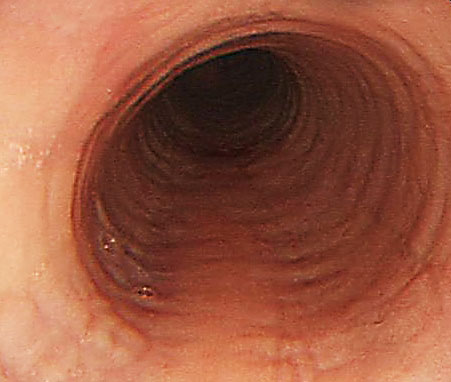About
Eosinophilic oesophagitis (EoE) is a condition that affects the
gullet (oesophagus). There is a build up of a particular type of
immune cell (eosinophils) in the lining of the gullet causing
inflammation or irritation. This affects how the gullet works,
causing symptoms such as difficulty swallowing. The condition is
diagnosed by using a telescope to look inside the gullet and take
small samples (called biopsies) of the lining. It can be a
long-standing condition, but it is not cancer and is not
life-threatening. It can be successfully managed with diet and/or
medications.

Figure 1. Characteristic endoscopic appearance of
trachealisation in eosinophilic oesophagits. Source: UHBW NHS
Foundation Trust.
We do not fully understand what causes EoE, but it is thought to
occur due to a combination of genetic makeup and the body's
response to the environment. We also know that it affects
more men than women and is also more likely if you have allergies
such as asthma or hay fever.
Difficulty swallowing
The main problem caused by EoE is usually difficulty swallowing.
The medical term for this is dysphagia. Some people find that food
may get stuck on the way down after chewing and swallowing. Often
food then slowly works its way down into the stomach, but sometimes
people will bring the food back up.
Regurgitation
Some people find that food or fluid they have swallowed comes
back up into the back of their throat. Usually this will be a small
amount, which some people automatically swallow again.
Indigestion, heart burn or pain
People with EoE may experience burning or an achy sensation in
the middle of the chest behind the breast bone or in the upper part
of the abdomen or tummy. Sometimes this can be severe and people
report feeling pain in this area. These symptoms are similar to
acid indigestion, which is very common. However, in people with
EoE, these symptoms will not respond to anti acid medications.
Chest pain
As the gullet is irritated and does not work normally, some
people with EoE experience pain in the middle of the chest. This
can be from irritation or inflammation, or from spasm of the muscle
in the gullet.
Weight loss
As people with EoE have difficulty eating and drinking normally,
they may reduce the amount they eat and drink, leading to weight
loss.